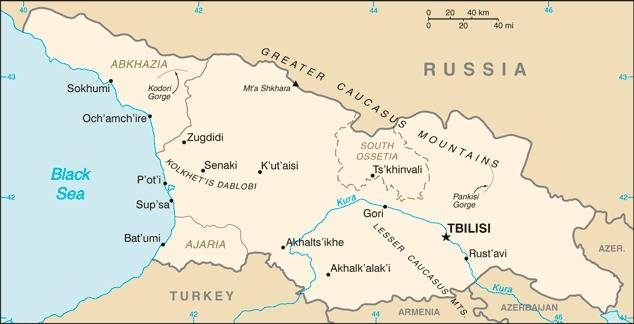139 Georgia

White rectangle with a central red cross extending to all four sides of the flag. Each of the four quadrants displays a small red bolnur-katskhuri cross. Sometimes referred to as the Five-Cross Flag. Although adopted as the official Georgian flag in 2004, the five-cross design is based on a 14th century banner of the Kingdom of Georgia.
Flag courtesy of the CIA World Factbook

Map courtesy of the CIA World Factbook

Metal doorway to the Jvari Monastery (Monastery of the Cross) at Mtskheta.
Photo courtesy of the CIA World Factbook
Government
According to Britannica, in 1992 Georgia, which had been operating under a Soviet-era constitution from 1978, reinstated its 1921 pre-Soviet constitution. A constitutional commission was formed in 1992 to draft a new constitution, and, after a protracted dispute over the extent of the authority to be accorded the executive, a new document was adopted in 1995.
Georgia is a unitary multiparty republic. Under the 1995 constitution the president was given extensive powers, but those were significantly reduced by constitutional amendments enacted in 2013 that expanded the role of the prime minister and the cabinet. Up through the presidential election of 2018, the president was elected to a maximum of two five-year terms by direct universal suffrage. Beginning in 2024, the president will be elected by an electoral college of 300 lawmakers and representatives. The legislature is an elected parliament whose members serve four-year terms. The judicial system includes district and city courts and a Supreme Court.
Georgian Civil Aviation Agency (CAA)
The Georgian Civil Aviation Agency (CAA) provides the following services:
- organization and coordination of international relations of the agency;
- cooperation with international organizations operating in the aviation field;
- receiving delegations of international civil aviation organizations and aviation authorities of other countries, organizing meetings and compiling and storing relevant documents;
- relations with the public and mass media – ensuring the transparency of the agency’s activities, informing the public about the agency’s annual reports and the situation in the relevant field;
- managing the agency’s human resources, managing the personal files of employees, preparing materials on official transfer of employees, incentives and disciplinary responsibility;
- management and coordination of training/retraining programs of agency employees;
- planning and organizing attendance of employees at internal and external training courses;
- ensuring the agency’s proceedings in accordance with the uniform rules of proceedings;
- the registration of administrative-legal acts of the director of the agency and the incoming and outgoing correspondence of the agency, as well as the analysis and control of the execution of control tasks, writing down the documents taken under control within the established period, timely delivery of correspondence;
- operation of aviation fixed telecommunication network facilities, receiving/sending correspondence;
- storage of archival materials, archive production.
Airspace
SkyVector – Google Maps – ADS-B Exchange
ICAO countries publish an Aeronautical Information Publication (AIP). This document is divided into three parts: General (GEN), En Route (ENR) and Aerodromes (AD). ENR 1.4 details the types of airspace classes they chose to adopt from classes A through G.
Drone Regulations
Advanced Air Mobility (AAM) Regulations & Policies
None found by the author.
However, should you, the reader, happen to stumble across something to the contrary, please email the author at FISHE5CA@erau.edu and you may be mentioned in the ACKNOWLEDGEMENTS section of this book by way of thanks for contributing to this free eBook!
Advanced Air Mobility (AAM) News
None found by the author.
However, should you, the reader, happen to stumble across something to the contrary, please email the author at FISHE5CA@erau.edu and you may be mentioned in the ACKNOWLEDGEMENTS section of this book by way of thanks for contributing to this free eBook!
Short Essay Questions
Scenario-Based Question
You have been hired by a Drone Startup Company. Your boss has immediately assigned this job to you.
They need you to prepare a one-page memo detailing the legalities of using a drone to film the monastery, pictured above.
They need you to mention any national laws and local ordinances.
They specifically want to know what airspace (insert pictures) you will be operating in and whether or not you need an airspace authorization.
Does it matter whether or not you are a citizen of the country?
Lastly, there is a bonus for you if, as you scroll through this chapter, you find any typos or broken links!
Short Essay Questions
- What are the drone categories?
- How is registration addressed?
- How is remote ID addressed?
- What are the model aircraft rules?
- What are the commercial drone rules?
- Are there waivers or exemptions to the rules? If so, for what?
- Would you share a link to an interactive airspace map?
- How is BVLOS addressed?
- How can you fly drones at night?
- How can you fly drones over people?
- Where do you find drone NOTAMs?
- What are the rules for drone maintenance?
- What are the rules for an SMS program?
- What are some unique rules not mentioned above?
- What are the C-UAS rules?
- What are the AAM rules?

